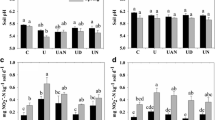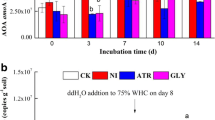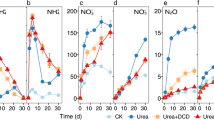Abstract
Purpose
Urease inhibitors (UIs) such as N-(n-butyl)thiophosphoric triamide (NBPT) and nitrification inhibitors (NIs) such as 3,4-dimethylpyrazole phosphate (DMPP) have been reported to improve the efficiency of nitrogen (N) fertilizers. However, their effects on the ureolytic and ammonia-oxidizing microbes in agricultural soils are uncertain. This study aimed to investigate the effects of DMPP and NBPT on the abundance and community composition of ureolytic and nitrifying microbes in selected agricultural soils in Australia.
Materials and methods
Soil was collected from five agricultural farms and used to establish an incubation experiment. Urea, urea + NBPT, urea + DMPP, and urea + NBPT + DMPP were applied on the soils which were incubated under 25 °C and 60% water-filled pore space for 28 days. Sampling was done on different days for DNA extraction and measurement of ammonium (NH4+) and nitrate (NO3−) concentration.
Results and discussion
NBPT inhibited NH4+ accumulation in all the soils but had no significant effect on nitrification in any soil. DMPP alone or DMPP + NBPT significantly inhibited nitrification. The abundances of ammonia-oxidizing bacteria (AOB) and complete ammonia oxidizers (comammox Nitrospira), but not ammonia-oxidizing archaea (AOA), were significantly influenced by the application of NBPT, DMPP, or DMPP + NBPT. AOA, AOB, and comammox Nitrospira clade B might be significant contributors to nitrification in the studied soils.
Conclusions
These findings suggest that NBPT and DMPP can reduce N losses and improve N fertilizer efficiency by directly inhibiting the growth of AOB and comammox organisms in the soils, with implications for our mechanistic understanding of the molecular mechanisms of urease and nitrification inhibitors.






Similar content being viewed by others
Abbreviations
- UIs:
-
Urease inhibitors
- NIs:
-
Nitrification inhibitors
- DMPP:
-
3,4-Dimethylpyrazole phosphate
- NBPT:
-
N-(n-Butyl)thiophosphoric triamide
- AOA:
-
Ammonia-oxidizing archaea
- AOB:
-
Ammonia-oxidizing bacteria
- Comammox:
-
Complete ammonia oxidizers
- PCR:
-
Polymerase chain reaction
- qPCR:
-
Quantitative polymerase chain reaction
- T-RFLP:
-
Terminal restriction fragment length polymorphism
References
Barth G, Von TS, Schmidhalter U (2001) Influence of soil parameters on the effect of 3, 4-dimethylpyrazole-phosphate as a nitrification inhibitor. Biol Fertil Soils 34:98–102
Beeckman F, Motte H, Beeckman T (2018) Nitrification in agricultural soils: impact, actors and mitigation. Curr Opin Biotechnol 50:166–173
Behrens S, Azizian MF, McMurdie PJ, Sabalowsky A, Dolan ME, Semprini L, Spormann AM (2008) Monitoring abundance and expression of “Dehalococcoides” species chloroethene-reductive dehalogenases in a tetrachloroethene-dechlorinating flow column. Appl Environ Microbiol 74:5695–5703
Burton SA, Prosser JI (2001) Autotrophic ammonia oxidation at low pH through urea hydrolysis. Appl Environ Microbiol 67:2952–2957
Cantarella H, Trivelin PCO, Contin TLM, Dias FLF, Rossetto R, Marcelino R, Coimbra RB, Quaggio JA (2008) Ammonia volatilisation from urease inhibitor-treated urea applied to sugarcane trash blankets. Sci Agric 65:397–401
Cantarella H, Otto R, Soares JR, de Brito Silva AG (2018) Agronomic efficiency of NBPT as a urease inhibitor: a review. J Adv Res 13:19–27
Chen D, Suter H, Islam A, Edis R, Freney JR, Walker CN (2008) Prospects of improving efficiency of fertiliser nitrogen in Australian agriculture: a review of enhanced efficiency fertilisers. Aust J Soil Res 46:289
Daims H, Lebedeva E, Pjevac P, Han P, Herbold C, Albertsen M, Jehmlich N, Palatinszky M, Vierheilig J, Bulaev A, Kirkegaard R, von Bergen M, Rattei T, Bendinger B, Nielsen P, Wagner M (2015) Complete nitrification by Nitrospira bacteria. Nature 528:504–509
Di HJ, Cameron KC (2011) Inhibition of ammonium oxidation by a liquid formulation of 3, 4-Dimethylpyrazole phosphate (DMPP) compared with a dicyandiamide (DCD) solution in six New Zealand grazed grassland soils. J Soils Sediments 11:1032–1039
Di HJ, Cameron KC (2016) Inhibition of nitrification to mitigate nitrate leaching and nitrous oxide emissions in grazed grassland: a review. J Soils Sediments 16:1401–1420
Dougherty W (2016) Nitrification (DMPP) and urease (NBPT) inhibitors had no effect on pasture yield, nitrous oxide emissions, or nitrate leaching under irrigation in a hot-dry climate. Soil Res 54:675–683
Engel RE, Williams E, Wallander R, Hilmer J (2013) Apparent persistence of N-(-butyl) thiophosphoric triamide is greater in alkaline soils. Soil Sci Soc Am J 77:1424–1429
Engel RE, Towey BD, Gravens E (2015) Degradation of the urease inhibitor NBPT as affected by soil pH. Soil Sci Soc Am J 79:1674–1683
Fan X, Yin C, Yan G, Cui P, Shen Q, Wang Q, Chen H, Zhang N, Ye M, Zhao Y (2018) The contrasting effects of N-(n-butyl) thiophosphoric triamide (NBPT) on N2O emissions in arable soils differing in pH are underlain by complex microbial mechanisms. Sci Total Environ 642:155–167
Fan X, Yin C, Chen H, Ye M, Zhao Y, Li T, Wakelin S, Liang Y (2019) The efficacy of 3,4-dimethylpyrazole phosphate on N2O emissions is linked to niche differentiation of ammonia oxidizing archaea and bacteria across four arable soils. Soil Biol Biochem 130:82–93
Fisher K, Yarwood S, James B (2017) Soil urease activity and bacterial ureC gene copy numbers: effect of pH. Geoderma 285:1–8
Fisk L, Maccarone L, Barton L, Murphy D (2015) Nitrapyrin decreased nitrification of nitrogen released from soil organic matter but not amoA gene abundance at high soil temperature. Soil Biol Biochem 88:214–223
Florio A, Clark I, Hirsch P, Jhurreea D, Benedetti A (2014) Effects of the nitrification inhibitor 3,4-dimethylpyrazole phosphate (DMPP) on abundance and activity of ammonia oxidizers in soil. Biol Fertil Soils 50:795–807
Frame W (2017) Ammonia volatilization from urea treated with NBPT and two nitrification inhibitors. Agron J 109:378–387
Gresham TLT, Sheridan P, Watwood M, Fujita Y, Colwell F (2007) Design and validation of ureC-based primers for groundwater detection of urea-hydrolyzing bacteria. Geomicrobiol J 24:353–364
Harty MA, Forrestal PJ, Watson CJ, McGeough KL, Carolan R, Elliot C, Krol D, Laughlin RJ, Richards KG, Lanigan GJ (2016) Reducing nitrous oxide emissions by changing N fertiliser use from calcium ammonium nitrate (CAN) to urea based formulations. Sci Total Environ 563:576–586
He JZ, Hu HW, Zhang LM (2012) Current insights into the autotrophic thaumarchaeal ammonia oxidation in acidic soils. Soil Biol Biochem 55:146–154
Hink L, Gubry-Rangin C, Nicol GW, Prosser JI (2018) The consequences of niche and physiological differentiation of archaeal and bacterial ammonia oxidisers for nitrous oxide emissions. ISME J 12:1084
Hu HW, He JZ (2017) Comammox—a newly discovered nitrification process in the terrestrial nitrogen cycle. J Soils Sediments 17:2709–2717
Hu HW, Chen D, He JZ (2015a) Microbial regulation of terrestrial nitrous oxide formation: understanding the biological pathways for prediction of emission rates. FEMS Microbiol Rev 39:729–749
Hu HW, Macdonald C, Trivedi P, Holmes B, Bodrossy L, He JZ, Singh B (2015b) Water addition regulates the metabolic activity of ammonia oxidizers responding to environmental perturbations in dry subhumid ecosystems. Environ Microbiol 17:444–461
IFA (2007) Sustainable management of the nitrogen cycle in agriculture and mitigation of reactive nitrogen side effects. IFA, Paris
Khan MJ, Malik A, Zaman M, Khan Q (2014) Nitrogen use efficiency and yield of maize crop as affected by agrotain coated urea in arid calcareous soils. Soil Environ 33:1–6
Kim DG, Saggar S, Roudier P (2012) The effect of nitrification inhibitors on soil ammonia emissions in nitrogen managed soils: a meta-analysis. Nutr Cycl Agroecosyst 93:51–64
Koch H, van Kessel MA, Lücker S (2019) Complete nitrification: insights into the ecophysiology of comammox Nitrospira. Appl Microbiol Biotechnol 103:177–189
Kong X, Duan Y, Schramm A, Eriksen J, Petersen SO (2016) 3, 4-Dimethylpyrazole phosphate (DMPP) reduces activity of ammonia oxidizers without adverse effects on non-target soil microorganisms and functions. Appl Soil Ecol 105:67–75
Li Y, Chapman SJ, Nicol GW, Yao H (2018) Nitrification and nitrifiers in acidic soils. Soil Biol Biochem 116:290–301
Li CY, Hu HW, Chen QL, Chen D, He JZ (2019) Growth of comammox Nitrospira is inhibited by nitrification inhibitors in agricultural soils. J Soils Sediments 1:8. https://doi.org/10.1007/s11368-019-02442-z
Liu R, Hayden H, Suter H, He J, Chen D (2015) The effect of nitrification inhibitors in reducing nitrification and the ammonia oxidizer population in three contrasting soils. J Soils Sediments 15:1113–1118
Manunza B, Deiana S, Pintore M, Gessa C (1999) The binding mechanism of urea, hydroxamic acid and N-(N-butyl)-phosphoric triamide to the urease active site. A comparative molecular dynamics study. Soil Biol Biochem 31:789–796
Marsden KA, Marín-Martínez AJ, Vallejo A, Hill PW, Jones DL, Chadwick DR (2016) The mobility of nitrification inhibitors under simulated ruminant urine deposition and rainfall: a comparison between DCD and DMPP. Biol Fertil Soils 52:491–503
O’Callaghan M, Gerard EM, Carter PE, Lardner R, Sarathchandra U, Burch G, Ghani A, Bell N (2010) Effect of the nitrification inhibitor dicyandiamide (DCD) on microbial communities in a pasture soil amended with bovine urine. Soil Biol Biochem 42:1425–1436
Ouyang Y, Evans SE, Friesen ML, Tiemann LK (2018) Effect of nitrogen fertilization on the abundance of nitrogen cycling genes in agricultural soils: a meta-analysis of field studies. Soil Biol Biochem 127:71–78
Palomo A, Pedersen AG, Fowler SJ, Dechesne A, Sicheritz-Pontén T, Smets BF (2018) Comparative genomics sheds light on niche differentiation and the evolutionary history of comammox Nitrospira. ISME J 12:1779–1793
Pereira J, Barneze AS, Misselbrook TH, Coutinho J, Moreira N, Trindade H (2013) Effects of a urease inhibitor and aluminium chloride alone or combined with a nitrification inhibitor on gaseous N emissions following soil application of cattle urine. Biosyst Eng 115:396–407
Persson T, Wirén A (1995) Nitrogen mineralization and potential nitrification at different depths in acid forest soils. Plant Soil 168:55–65
Philippot L, Hallin S, Schloter M (2007) Ecology of denitrifying prokaryotes in agricultural soil. Adv Agron 96:249–305
Pjevac P, Schauberger C, Poghosyan L, Herbold CW, van Kessel MA, Daebeler A, Steinberger M, Jetten MS, Lücker S, Wagner M (2017) AmoA-targeted polymerase chain reaction primers for the specific detection and quantification of comammox Nitrospira in the environment. Front Microbiol 8:1508
Prosser JI, Embley TM (2002) Cultivation-based and molecular approaches to characterisation of terrestrial and aquatic nitrifiers. Antonie Van Leeuwenhoek 81:165–179
Recio J, Vallejo A, Le-Noe J, Garnier J, García-Marco S, Álvarez JM, Sanz-Cobena A (2018) The effect of nitrification inhibitors on NH3 and N2O emissions in highly N fertilized irrigated Mediterranean cropping systems. Sci Total Environ 636:427–436
Rotthauwe JH, Witzel KP, Liesack W (1997) The ammonia monooxygenase structural gene amoA as a functional marker: molecular fine-scale analysis of natural ammonia-oxidizing populations. Appl Environ Microbiol 63:4704–4712
Ruser R, Schulz R (2015) The effect of nitrification inhibitors on the nitrous oxide (N2O) release from agricultural soils—a review. J Plant Nutr Soil Sci 178:171–188
San Francisco S, Urrutia O, Martin V, Peristeropoulos A, Garcia-Mina JM (2011) Efficiency of urease and nitrification inhibitors in reducing ammonia volatilization from diverse nitrogen fertilizers applied to different soil types and wheat straw mulching. J Sci Food Agric 91:1569–1575
Sanz-Cobena A, Abalos D, Meijide A, Sanchez-Martin L, Vallejo A (2014) Soil moisture determines the effectiveness of two urease inhibitors to decrease N2O emission. Mitig Adapt Strat Gl Change 21:1–14
Shi X, Hu H, He J, Chen D, Suter HC (2016) Effects of 3, 4-dimethylpyrazole phosphate (DMPP) on nitrification and the abundance and community composition of soil ammonia oxidizers in three land uses. Biol Fertil Soils 52:927–939
Shi X, Hu HW, Kelly K, Chen D, He JZ, Suter H (2017) Response of ammonia oxidizers and denitrifiers to repeated applications of a nitrification inhibitor and a urease inhibitor in two pasture soils. J Soils Sediments 17:974–984
Smoleń S, Sady W, Wierzbińska J (2012) The influence of nitrogen fertilization with ENTEC-26 and ammonium nitrate on the concentration of thirty-one elements in carrot (Daucus carota L.) storage roots. J Elem 17:115–137
Soares JR, Cantarella H, de Campos Menegale ML (2012) Ammonia volatilization losses from surface-applied urea with urease and nitrification inhibitors. Soil Biol Biochem 52:82–89
Sunderlage B, Cook RL (2018) Soil property and fertilizer additive effects on ammonia volatilization from urea. Soil Sci Soc Am J 82:253–259
Suter H, Pengthamkeerati P, Walker C, Chen D (2011) Influence of temperature and soil type on inhibition of urea hydrolysis by N-(n-butyl) thiophosphoric triamide in wheat and pasture soils in South-eastern Australia. Soil Res 49:315–319
Suter H, Sultana H, Davies R, Walker C, Chen D (2016) Influence of enhanced efficiency fertilisation techniques on nitrous oxide emissions and productivity response from urea in a temperate Australian ryegrass pasture. Soil Res 54:523–532
Thapa R, Chatterjee A, Awale R, McGranahan DA, Daigh A (2016) Effect of enhanced efficiency fertilizers on nitrous oxide emissions and crop yields: a meta-analysis. Soil Sci Soc Am J 80:1121–1134
Tourna M, Freitag T, Nicol G, Prosser J (2008) Growth, activity and temperature responses of ammonia-oxidizing archaea and bacteria in soil microcosms. Environ Microbiol 10:1357–1364
Trenkel ME (1997) Controlled-release and stabilized fertilizers in agriculture. Paris: International Fertilizer Industry Association 11:1–56
van Kessel MA, Speth DR, Albertsen M, Nielsen PH, den Camp HJO, Kartal B, Jetten MS, Lücker S (2015) Complete nitrification by a single microorganism. Nature 7583:555–559
Watson C, Akhonzada N, Hamilton J, Matthews D (2008) Rate and mode of application of the urease inhibitor N-(n-butyl) thiophosphoric triamide on ammonia volatilization from surface-applied urea. Soil Use Manag 24:246–253
Wissemeier A, Linzmeier W, Gutser R, Weigelt W, Schmidhalter U (2001) The new nitrification inhibitor DMPP (ENTEC®)—comparisons with DCD in model studies and field applications. In: Horst WJ, Schenk MK, Bürkert A, Claassen N, Flessa H, Frommer WB et al (eds) Plant nutrition: food security and sustainability of agro-ecosystems through basic and applied research., Plant Nutrition. Springer, Dordrecht 702–703
Yan XU, Zhi-jie WU, Li-li ZH, Ping GO, Xin-xin DO, Yan-xia NI (2012) Inhibitory effect of DMPP on soil nitrification as affected by soil moisture content, pH and organic matter. Chin J Appl Ecol 23:2663–2669
Zaman M, Saggar S, Blennerhassett J, Singh J (2009) Effect of urease and nitrification inhibitors on N transformation, gaseous emissions of ammonia and nitrous oxide, pasture yield and N uptake in grazed pasture system. Soil Biol Biochem 41:1270–1280
Zaman M, Nguyen M, Šimek M, Nawaz S, Khan M, Babar M, Zaman S (2012) Emissions of nitrous oxide (N2O) and di-nitrogen (N2) from the agricultural landscapes, sources, sinks, and factors affecting N2O and N2 ratios. In: Guoxiang L (ed)Greenhouse Gases-Emission, Measurement and Management. IntechOpen 1–32
Zerulla W, Barth T, Dressel J, Erhardt K, von Locquenghien KH, Pasda G, Rädle M, Wissemeier A (2001) 3, 4-Dimethylpyrazole phosphate (DMPP)—a new nitrification inhibitor for agriculture and horticulture. Biol Fertil Soils 34:79–84
Zhang LM, Hu HW, Shen JP, He JZ (2012) Ammonia-oxidizing archaea have more important role than ammonia-oxidizing bacteria in ammonia oxidation of strongly acidic soils. ISME J 6:1032
Zhang M, Wang W, Bai S, Zhou X, Teng Y, Xu Z (2018a) Antagonistic effects of nitrification inhibitor 3,4-dimethylpyrazole phosphate and fungicide iprodione on net nitrification in an agricultural soil. Soil Biol Biochem 116:167–170
Zhang Y, Ding H, Zheng X, Ren X, Cardenas L, Carswell A, Misselbrook T (2018b) Land-use type affects N2O production pathways in subtropical acidic soils. Environ Pollut 237:237–243
Zhang Q, Li Y, He Y, Liu H, Dumont M, Brookes P, Xu J (2019) Nitrosospira cluster 3-like bacterial ammonia oxidizers and Nitrospira-like nitrite oxidizers dominate nitrification activity in acidic terrace paddy soils. Soil Biol Biochem 131:229–237
Acknowledgments
We acknowledge the financial support from the Australian Research Council (LP160101134) and the Melbourne Trace Analysis for Chemical, Earth, and Environmental Sciences (TrACEES), The University of Melbourne, for the analytical support.
Author information
Authors and Affiliations
Corresponding author
Additional information
Responsible editor: Huaiying Yao
Publisher’s note
Springer Nature remains neutral with regard to jurisdictional claims in published maps and institutional affiliations.
Electronic supplementary material
ESM 1
(DOCX 2.21 mb)
Rights and permissions
About this article
Cite this article
Luchibia, A.O., Suter, H., Hu, HW. et al. Responses of ureolytic and nitrifying microbes to urease and nitrification inhibitors in selected agricultural soils in Victoria, Australia. J Soils Sediments 20, 1309–1322 (2020). https://doi.org/10.1007/s11368-020-02562-x
Received:
Accepted:
Published:
Issue Date:
DOI: https://doi.org/10.1007/s11368-020-02562-x




